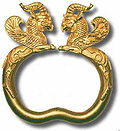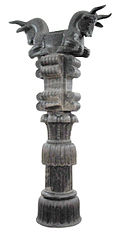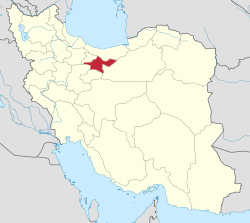National Museum of Iran
 From Wikipedia - Reading time: 18 min
From Wikipedia - Reading time: 18 min
This article has multiple issues. Please help improve it or discuss these issues on the talk page. (Learn how and when to remove these messages)
|
موزهٔ ملی ایران Muze-ye Melli-ye Irān | |
 | |
 Facade of the National Museum of Iran, Tehran | |
 | |
| Established | 1937; 86 years |
|---|---|
| Location | Tehran, Iran |
| Type | Archaeology museum |
| Collection size | +3 million (300,000 on display) [1] |
| Visitors | 500,000 (2011) [2] |
| Director | Jebrael Nokandeh |
| Owner | ICHTO |
| Website | irannationalmuseum.ir |
The National Museum of Iran (Persian: موزهٔ ملی ایران Mūze-ye Melli-ye Irān) is located in Tehran, Iran. It is an institution formed of two museums; the Museum of Ancient Iran and the Museum of the Islamic Era, which were opened in 1937 and 1972, respectively. The institution hosts historical monuments dating back through preserved ancient and medieval Iranian antiquities. It also includes a number of research departments, categorized by different historical periods and archaeological topics. National Museum of Iran is the world's most important museum in terms of preservation, display and research of archaeological collections of Iran, and currently displays works that express the richness of history, culture, civilization, art, economic growth and technological achievements of Iran.[3]
History
[edit]For the first time, the proposal to create a place called "Museum" was made by Morteza Gholi Khan Hedayat.[4] He was thinking of creating a museum and an office called the Department of Antiquities to organize commercial explorations, but he did not achieve this goal. The first museum was established in 1916 under the name of "National Museum" or "Museum of Education" in one of the rooms of the Ministry of Education, which was located on the north side of the Dar al-Funun school building.[5] This museum had 270 bronze artefacts (pottery, glass, coins, old weapons, seals, wooden objects, patches, books and textiles) which were collected by the employees of the Antiquities Department or donated by the people. In 1925, the objects of this museum were moved to the Mirorr Hall at Masoudiyeh Palace.

With the start of excavations by European archaeologists, especially the French archaeological team headed by Jacques de Morgan in Susa (1897) the people's attention was drawn to the importance of cultural heritage. In 1927, the unconditional privilege of the French archaeologists in Iran was canceled. They were allowed to dig only in Susa.[6] Since Iran had decided to establish a national museum and library, the privilege of designing and implementing it was given to France.[7] For this purpose, French architecture Andre Godard came to Iran in 1929 to establish a museum and library and officially started his work.
The brick building of the Museum of Ancient Iran was designed by André Godard and Maxime Siroux in the early 20th century, and was influenced by Sassanian vaults, particularly the Taq Kasra at Ctesiphon.[8] Its construction, with an area of about 11,000 square metres (13,000 sq yd), began in 1935 and was completed within two years by Abbas Ali Memar and Morad Tabrizi. It was then officially inaugurated in 1937.[9]
The Museum of the Islamic Era was later built with white travertine on the grassy grounds of the Museum of Ancient Iran. It was still being remodeled when the Iranian Revolution swept the country.

While the Museum of Ancient Iran always had a clear mandate to show archaeological relics, as well as some rare medieval textiles and rug pieces, the newer complex began to also feature the Amlash pottery from prehistoric Caspian Sea regions of Iran. The Museum of the Islamic Era exhibits over 1,500 works from Ilkanids, Seljuks, Timurids, Safavids, Qajars and more. The complex consists of three floors, and it also contains various pieces of pottery, textiles, texts, artworks, astrolabes, and adobe calligraphy, from Iran's post-classical era.

The oldest artifacts kept at the Ancient Iran Museum are from Kashafrud, Darband, and Shiwatoo, which date back to the Lower Paleolithic period. Mousterian stone tools made by Neanderthals are also on display at the first hall of the Museum of Ancient Iran. The most important Upper Paleolithic tools are from Yafteh, dating back about 30,000 to 35,000 years. The Museum of Ancient Iran consists of two floors. Its halls contain artifacts and fossils from the Lower, Middle, and Upper Paleolithic, as well as the Neolithic, Chalcolithic, early and late Bronze Age, and Iron Ages I-III, through the Elamite, Median, Achaemenid, Seleucid, Parthian, and Sassanian eras.
Exhibitions
[edit]To celebrate its 80th anniversary in 2018, the museum hosted 50 masterpieces from the Louvre and the Musée national Eugène Delacroix.[10][11] The exhibition attracted over 250,000 visitors.[12][13]
In 2005–2006, the National Museum of Iran and the British Museum held a major exhibition. It was held in collaboration with the Iranian government, which loaned the British Museum a number of iconic artefacts in exchange for an undertaking that the Cyrus Cylinder would be loaned to the National Museum of Iran in return.[14] The planned loan of the Cylinder was postponed to October 2009 following the June 2009 Iranian presidential election.[15] The Cylinder was displayed in September 2010 for a four-month period.[16] The exhibition was very popular, attracting 48,000 people within the first ten days and about 500,000 people by the time it closed in January 2011.[17]
One of the other successful exhibitions, entitled "Evidence for Two Hundred Thousand Years of Human-Animal Bonds in Iran", ran from August to October 2014.[18]
An ancient Sassanid relief (224 - 651 AD), illegally smuggled to the United Arab Emirates during the Iran–Iraq War (1980-1988), and left there in 2006, was later seized in the United Kingdom in 2016. Its value at an auction could exceed £30 million.[19] The Iranian government was tracking the long-missing relief for years. In 2023, The Guardian reported that the relief had been discovered and confiscated at Stansted Airport near London.[20] The British Museum received permission to display the relief for a short period of time, and then returned it to Iran. After 35 years, on 28 June 2023, the Sassanid relief returned to Iran and a well-received exhibition was held. It is now permanently displayed at the National Museum of Iran.[21]
After 85 years, Iran showcased 3,506 Achaemenid tablets at the National Museum on May 18, 2024, after legally reclaiming them from the US in 2023. The tablets, which were originally provided to the University of Chicago for study in 1930s, were discovered in Persepolis and lent to the United States for a three-year study period. The tablets were repatriated on the plane that also brought home the Iranian delegation from New York, after it attended the United Nations General Assembly. The tablets are among the most important works of Iranian history, and contain vital insights into road resource management, social relations, basic necessities of life, wages, and the economy of Achaemenid society, related to the reign of Darius the Great (522–486 BC).[22][23][24][25]
Departments
[edit]| Department | Head |
|---|---|
| Paleolithic Department | Fereidoun Biglari |
| Osteological Department | |
| Prehistoric Department | Fariba Mojezati |
| Historic Department | Firouzeh Babaei |
| Islamic Department | Karam Mirzaei |
| Coins and seals Department | |
| Inscriptions Department | Piran |
| Pottery Department | Omolbanin Ghafouri |
Management
[edit]| Name | Education/Activities |
|---|---|
| Andre Godard
(1939-?) |
French architect, archaeologist and researcher. Head of the department of Antiquities and Museum of Ancient Iran and the founder of the National Museum of Iran. The designer of: National Library building, the tomb of Hafez, the tomb of Ferdowsi and the tomb of Saadi. The founder of the faculty of Fine Arts in the University of Tehran, and the first manager of this faculty. |
| Jebrael Nokandeh
(Since 2015) |
PhD in archeology from the Institute of Near Eastern Archeology (Berlin). Opening the section related to the prehistoric period, completing the restoration operation of the Museum of Islamic Arts after 9 years, integrating the data of different sections, organizing storage areas and producing different catalogs of the museum's important collections, and holding joint programs between the National Museum of Iran and the largest museums around the world such as Louvre, Museum Island etc. |
Gallery
[edit]-
Museum of Ancient Iran, part of the National Museum of Iran.
-
Organizational chart of National Museum of Iran
-
The entrance of the Museum of Ancient Iran, part of the National Museum of Iran.
-
Museum of the Islamic Era, part of the National Museum of Iran.
-
An Iron-Age animal statue from Marlik, kept at the Museum of Ancient Iran.
-
A chopper from the Lower Paleolithic, found at Kashafrud, kept at the Museum of Ancient Iran.
-
A trihedral from the Lower Paleolithic, found at Amar Merdeg, kept at the Museum of Ancient Iran.
-
A clay boar figurine from the Neolithic period, found at Tepe Sarab, kept at the Museum of Ancient Iran.
-
The Saltmen, kept at the Museum of Ancient Iran.
-
A clay figurine of a fertility goddess found at Tepe Sarab, dating back to the Neolithic, kept at the Museum of Ancient Iran.
-
A chlorite object with the Master of Animals motif from Kerman's Jiroft culture, dating back to Bronze Age I, kept at the Museum of Ancient Iran.
-
An Elamite bull statue, kept at the Museum of Ancient Iran.
-
The statue of a Parthian nobleman, kept at the Museum of Ancient Iran.
-
An Achaemenid mastiff statue, kept at the Museum of Ancient Iran.
-
The statue of Darius the Great, kept at the Museum of Ancient Iran.
-
A statue of a Sasanian nobleman from Hajjiabad, Fars, kept at the Museum of Ancient Iran.
-
A 9th-century ceramic bowl from Gorgan, decorated with slip beneath a transparent glaze, designing an anthropic figure with bull head, kept at the Museum of the Islamic Era.
-
A 19th-century hookah, kept at the Museum of the Islamic Era.
-
An 18th-century watercolor painting signed by Abol-Hasan Qaffari (Sani-ol-Molk), from the Qajar period, kept at the Museum of the Islamic Era.
-
One of the four remaining statues of Penelope was discovered in Persepolis, and is kept at the National Museum of Iran. The other three are at Vatican Museum and Capitoline Museum.[26]
See also
[edit]References
[edit]- ^ https://www.farsnews.ir/news/14010401000314/3-%D9%85%DB%8C%D9%84%DB%8C%D9%88%D9%86-%D8%A7%D8%AB%D8%B1-%D8%AA%D8%A7%D8%B1%DB%8C%D8%AE%DB%8C-%D8%A7%D8%B1%D8%B2%D8%B4%D9%85%D9%86%D8%AF-%D8%AF%D8%B1-%D9%82%D9%84%D8%A8-%D8%AA%D9%87%D8%B1%D8%A7%D9%86-%D9%85%D9%88%D8%B2%D9%87-%D9%85%D9%84%DB%8C-%D8%A7%DB%8C%D8%B1%D8%A7%D9%86-%DA%86%D9%82%D8%AF%D8%B1-%D8%AF%D8%B1 [bare URL]
- ^ "Diplomatic whirl". The Economist.
- ^ "Otraq.com, Iran's Tourism Guide" Archived 2014-10-20 at the Wayback Machine
- ^ "مرتضی قلی خان هدایت موسس موزه ملی". Mag Iran. 21 December 2023.
- ^ "موزه ملی ایران؛ موزه ایران باستان و دوران اسلامی". Safar Market. 21 December 2023.
- ^ Scheil, V. (21 December 2023). "Excavations made by the French in Susa and Babylonia, 1902-1903". The Biblical World. 24 (2): 146–152. doi:10.1086/473448. JSTOR 3140967. S2CID 143158851.
- ^ The First British and French Archaeological Investigations in Susa during the 19th century. Études orientales, slaves et néo-helléniques. Presses universitaires de Strasbourg. 21 December 2023. pp. 199–213. ISBN 979-10-344-0472-8.
{{cite book}}:|website=ignored (help) - ^ Sandy Isenstadt, Kishwar Rizvi. Modernism and the Middle East: Architecture and Politics in the Twentieth Century. Studies in Modernity and National Identity. University of Washington Press, 2011. ISBN 0295800305 pp.14
- ^ Nokandeh, Jebrael (ed.) 2019. A Survey of the History of Iran on the Basis of Iran National Museum Collections, Second edition, Iran National Museum with the contribution of Baloot Noghrei Institute, Tehran
- ^ "The Louvre at Tehran". Louvre. 6 June 2018.
- ^ "Louvre show opens in Tehran as cultural diplomacy thrives". The Guardian. 20 December 2023.
- ^ "The Louvre in Tehran". Euronews. 1 March 2018.
- ^ "موزه لوور تهران امروز به کار خود پایان میدهد/بازدید ۲۵۰ هزار نفر از موزه معروف فرانسه". Fars News. 20 December 2023.
- ^ "British Museum in battle with Iran over ancient 'charter of rights'". The Guardian. 20 December 2023.
- ^ "Historic Cyrus Cylinder called a stranger in its own home". Radio Free Europe. 20 December 2023.
- ^ "Diplomatic Whirl". The Economist. 20 December 2023.
- ^ "Cyrus Cylinder warmly welcomed at home". Tehran Times. 20 December 2023.
- ^ "The Guardian's report about exhibition"
- ^ "Smuggled Iranian carving worth £30m seized at airport by UK border control". The Guardian. 20 December 2023.
- ^ "Sassanid statue back Iran after 35 years". Ifp News. 20 December 2023.
- ^ "Lost Sassanid soldier". Iran Safar. 20 December 2023.
- ^ "رونمایی از الواح هخامنشی". ایسنا (in Persian). 18 May 2024. Retrieved 18 May 2024.
- ^ "163 Achaemenid tablets showcased at National Museum of Iran". Mehr News Agency. 18 May 2024. Retrieved 18 May 2024.
- ^ "ویدیو/ رونمایی از ۳۵۰۰ لوح هخامنشی بعد از ۹ ماه". ایسنا (in Persian). 18 May 2024. Retrieved 18 May 2024.
- ^ "۱۶۳ لوح هخامنشی به نمایش گذاشته شد". خبرگزاری مهر | اخبار ایران و جهان | Mehr News Agency (in Persian). 18 May 2024. Retrieved 18 May 2024.
- ^ "Statue Of Peace, A Journey From Persepolis To Rome And Back (PHOTOS) - Iran Front Page". ifpnews.com. 29 September 2015. Retrieved 26 December 2023.
External links
[edit]- Official website of Iran National Museum
- Official website of Journal of Iran National Museum
- Photo Gallery of the National Museum of Iran
- Virtual Tour of Iran National Museum 1 [1] Archived 2020-08-16 at the Wayback Machine
- Virtual Tour of Iran National Museum 2 [2]
 KSF
KSF
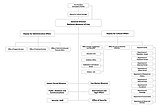









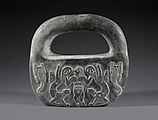









![One of the four remaining statues of Penelope was discovered in Persepolis, and is kept at the National Museum of Iran. The other three are at Vatican Museum and Capitoline Museum.[26]](https://upload.wikimedia.org/wikipedia/commons/thumb/b/b1/Achamanid-Woman-Statue-Persia-Persepolis.jpg/90px-Achamanid-Woman-Statue-Persia-Persepolis.jpg)

